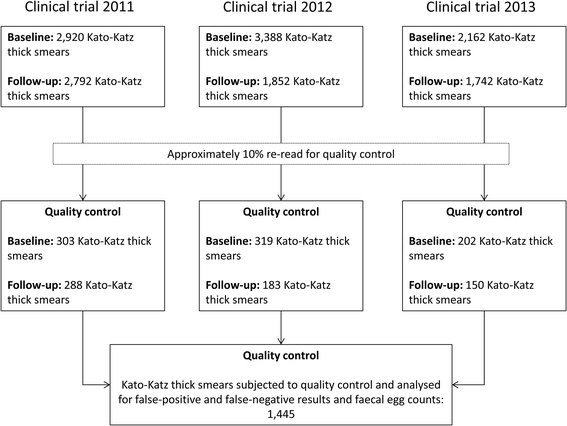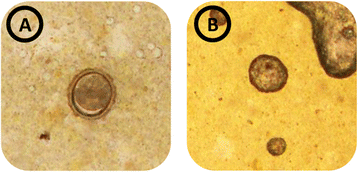Quality control in the diagnosis of Trichuris trichiura and Ascaris lumbricoides using the Kato-Katz technique: experience from three randomised controlled trials
- PMID: 25652120
- PMCID: PMC4326492
- DOI: 10.1186/s13071-015-0702-z
Quality control in the diagnosis of Trichuris trichiura and Ascaris lumbricoides using the Kato-Katz technique: experience from three randomised controlled trials
Abstract
Background: An accurate diagnosis of soil-transmitted helminthiasis is important for individual patient management, for drug efficacy evaluation and for monitoring control programmes. The Kato-Katz technique is the most widely used method detecting soil-transmitted helminth eggs in faecal samples. However, detailed analyses of quality control, including false-positive and faecal egg count (FEC) estimates, have received little attention.
Methods: Over a 3-year period, within the frame of a series of randomised controlled trials conducted in Pemba, United Republic of Tanzania, 10% of randomly selected Kato-Katz thick smears were re-read for Trichuris trichiura and Ascaris lumbricoides eggs. In case of discordant result (i.e. positive versus negative) the slides were re-examined a third time. A result was assumed to be false-positive or false-negative if the result from the initial reading did not agree with the quality control as well as the third reading. We also evaluated the general agreement in FECs between the first and second reading, according to internal and World Health Organization (WHO) guidelines.
Results: From the 1,445 Kato-Katz thick smears subjected to quality control, 1,181 (81.7%) were positive for T. trichiura and 290 (20.1%) were positive for A. lumbricoides. During quality control, very low rates of false-positive results were observed; 0.35% (n = 5) for T. trichiura and 0.28% (n = 4) for A. lumbricoides. False-negative readings of Kato-Katz thick smears were obtained in 28 (1.94%) and 6 (0.42%) instances for T. trichiura and A. lumbricoides, respectively. A high frequency of discordant results in FECs was observed (i.e. 10.0-23.9% for T. trichiura, and 9.0-11.4% for A. lumbricoides).
Conclusions: Our analyses show that the rate of false-positive diagnoses of soil-transmitted helminths is low. As the probability of false-positive results increases after examination of multiple stool samples from a single individual, the potential influence of false-positive results on epidemiological studies and anthelminthic drug efficacy studies should be determined. Existing WHO guidelines for quality control might be overambitious and might have to be revised, specifically with regard to handling disagreements in FECs.
Figures


Similar articles
-
Diagnostic comparison between FECPAKG2 and the Kato-Katz method for analyzing soil-transmitted helminth eggs in stool.PLoS Negl Trop Dis. 2018 Jun 4;12(6):e0006562. doi: 10.1371/journal.pntd.0006562. eCollection 2018 Jun. PLoS Negl Trop Dis. 2018. PMID: 29864132 Free PMC article. Clinical Trial.
-
The concentration McMaster method for diagnosis of patent Ascaris and Trichuris infections in humans.Int J Parasitol. 2024 Nov;54(13):717-722. doi: 10.1016/j.ijpara.2024.08.004. Epub 2024 Aug 30. Int J Parasitol. 2024. PMID: 39209212
-
Estimating the sensitivity and specificity of Kato-Katz stool examination technique for detection of hookworms, Ascaris lumbricoides and Trichuris trichiura infections in humans in the absence of a 'gold standard'.Int J Parasitol. 2010 Mar 15;40(4):399-404. doi: 10.1016/j.ijpara.2009.09.003. Epub 2009 Sep 20. Int J Parasitol. 2010. PMID: 19772859 Free PMC article.
-
Efficacy of single-dose 500 mg mebendazole in soil-transmitted helminth infections: a review.J Helminthol. 2018 May;92(3):269-278. doi: 10.1017/S0022149X17000426. Epub 2017 Jul 18. J Helminthol. 2018. PMID: 28716158 Review.
-
Immunity, immunoregulation and the ecology of trichuriasis and ascariasis.Parasite Immunol. 2004 Nov-Dec;26(11-12):429-41. doi: 10.1111/j.0141-9838.2004.00730.x. Parasite Immunol. 2004. PMID: 15771679 Review.
Cited by
-
Potential associations between Schistosoma mansoni infection and physico-chemical characteristics and water-related human activities in Côte d'Ivoire: a cross-sectional study.Parasit Vectors. 2024 Oct 8;17(1):422. doi: 10.1186/s13071-024-06466-4. Parasit Vectors. 2024. PMID: 39380000 Free PMC article.
-
Efficacy and Safety of Albendazole in Hookworm-infected Preschool-aged Children, School-aged Children, and Adults in Côte d'Ivoire: A Phase 2 Randomized, Controlled Dose-finding Trial.Clin Infect Dis. 2021 Jul 15;73(2):e494-e502. doi: 10.1093/cid/ciaa989. Clin Infect Dis. 2021. PMID: 32668456 Free PMC article. Clinical Trial.
-
Diagnosis of soil-transmitted helminths using the Kato-Katz technique: What is the influence of stirring, storage time and storage temperature on stool sample egg counts?PLoS Negl Trop Dis. 2021 Jan 22;15(1):e0009032. doi: 10.1371/journal.pntd.0009032. eCollection 2021 Jan. PLoS Negl Trop Dis. 2021. PMID: 33481808 Free PMC article.
-
Diagnostic performance of a single and duplicate Kato-Katz, Mini-FLOTAC, FECPAKG2 and qPCR for the detection and quantification of soil-transmitted helminths in three endemic countries.PLoS Negl Trop Dis. 2019 Aug 1;13(8):e0007446. doi: 10.1371/journal.pntd.0007446. eCollection 2019 Aug. PLoS Negl Trop Dis. 2019. PMID: 31369558 Free PMC article. Clinical Trial.
-
National mapping of soil-transmitted helminth and schistosome infections in Ethiopia.Parasit Vectors. 2020 Sep 1;13(1):437. doi: 10.1186/s13071-020-04317-6. Parasit Vectors. 2020. PMID: 32873333 Free PMC article.
References
-
- Murray CJL, Vos T, Lozano R, Naghavi M, Flaxman AD, Michaud C, et al. Disability-adjusted life years (DALYs) for 291 diseases and injuries in 21 regions, 1990–2010: a systematic analysis for the Global Burden of Disease Study 2010. Lancet. 2012;380:2197–223. doi: 10.1016/S0140-6736(12)61689-4. - DOI - PubMed
-
- Katz N, Chaves A, Pellegrino J. A simple device for quantitative stool thick-smear technique in schistosomiasis mansoni. Rev Inst Med Trop São Paulo. 1972;14:397–400. - PubMed
Publication types
MeSH terms
LinkOut - more resources
Full Text Sources
Other Literature Sources
Research Materials

